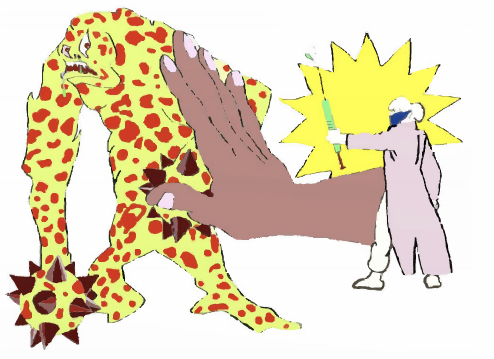Oregon is dangerously close to a measles outbreak. Coupled with the anti-vaccine movement—or as Dr. Ken Stedman, resident virologist at Portland State University, puts it: the “pro-disease” movement—we may be in for the perfect storm. In January, health officials in Washington declared a state of emergency as more and more children came down with Measles in Clark County, just across the Columbia River from Portland. Since January 1st there have been 70 confirmed cases, and 61 of them are unimmunized children (not all could confirm their immunization status). Four cases are in Multnomah County, Oregon.
Measles is a highly contagious virus that scientists expected to eradicate given there is an incredibly effective vaccine. However, according to the Centers for Disease Control and Prevention (CDC), 7.5 percent of kindergartners enrolled in Oregon between 2016–2018 were not vaccinated for nonmedical reasons; it was the highest rate of nonmedical exemptions in the country. There is an abundance of misinformation fueling the anti-vaccine movement, and it behooves all of us to turn to the experts—all the way down to the basics.
What is a virus?
“A virus is a bag of genes,” Stedman said. He researches viruses that live in volcanic hot springs and was mentioned in The New York Times for discovering a way to reversibly inactivate viruses; this method is important because it allows vaccines to not need to be kept cold during transport in developing countries.
All viruses are host-dependent, meaning without a host, a virus can’t replicate (aka reproduce for this non-living life form). In fact, whether or not viruses are actually alive is up for debate. As of now, all cellular life is divided into three domains: Eukarya, Bacteria and Archaea. But viruses? “They’re part of life,” Stedman tells his virology class with a smile. Sure, viruses use DNA or RNA (the molecules responsible for storing and communicating genetic information) just like other life, but they must hijack the machinery of another living being’s cells in order to replicate and persist.
You may be surprised to discover that not all viruses are harmful, or even infectious to humans. Most infect specific hosts. We tend to know the most about the ones that impact human and crop health because there is more incentive to research them. Furthermore, all of us are made up of viruses in a way. According to Stedman, anywhere from 10 to 40 percent of human DNA came from viruses! Compare that to the fact that only 1.5 percent of our genome encodes protein. It begs the question: Are humans more viral than human?
Fun fact—measles comes from a family of viruses that have been around longer than humans: the Morbilliviruses. However, the measles virus itself is relatively new, and is thought to have emerged in the early 20th century from a cattle virus called rinderpest—rinderpest translates to meat disease from German. “The most successful viruses,” Stedman said, “are those that don’t cause much in the way of disease.” That is because the virus does not want to kill the host—it’s home! The way our immune system responds to a pathogenic virus is often more harmful than the virus itself.

Measles Symptoms and Transmission
The symptoms of measles infection begin with a high fever, cough, runny nose, and watery eyes. However, the rash does not develop until the fourth day, and up until that time, patients are typically unaware that they are chaufferring around a highly contagious viral disease. This phenomenon is what Stedman refers to as “naivety of infection,” that period of time where your immune system is beginning to kick in, but you are still unaware of your infection. It is so contagious because it is transmitted via aerosols, which are tiny droplets or particles in the air. When a person talks, coughs, sneezes, or even breathes, they emit aerosols. If a person is infected with the measles virus, it can be spread to others with unbelievable ease. If that person leaves a room before you enter it, you could catch measles up to two hours after they are gone.
How does an outbreak occur?
Undervaccinated populations and naivety of infection are strong foreshadowings of an outbreak. Herd immunity refers to the protection of an entire community from disease by reaching a certain threshold of people who are immunized. The more members of the “herd” that are immune to a disease, the less likely an infection spreads through a population. Since viruses rely on hosts, if we eliminate a certain amount of hosts a virus can infect, we decrease its likelihood of jumping from host to host. Vaccination is important because not everyone is healthy enough to get vaccinated, such as those who are immunocompromised. Consider children who are not yet of age to receive a vaccine—they are already susceptible to infection. If they are on chemotherapy for cancer, which suppresses the immune system, exposure to infectious agents is more dangerous.
Scientists say that the threshold immunity for measles is 95 percent. However, more communities across the world are falling beneath that level. An outbreak often begins with travel, according to Stedman. For example, there are current measles outbreaks in the Philippines and Madagascar, where vaccination rates are well beneath the 95 percent immunity threshold. The alarming trend of nonmedical vaccine exemption emerging in Oregon is taking a toll on herd immunity. The Oregonian reported that 65 percent of charter public schools fall beneath the 95 percent threshold needed to effectively disrupt the chain of transmission for measles and stave off an outbreak. Ideally, the 5 percent of the population that does not get vaccinated are only those that cannot due to medical reasons. They are precisely why healthy children should be vaccinated. Infections like measles pose serious threats to communities with vaccination rates under the 95 percent threshold, because symptoms might not arise until days after someone is infected, making it difficult to contain.
How Vaccines Work
Vaccination is so common now that it can be easy to take for granted, but disease was a dismal death sentence before vaccines were an option. Smallpox, for instance, was devastating, and killed 300 million people in the 20th century alone. It has been eradicated thanks to a vaccine created by Edward Jenner when he discovered that the cowpox virus could be used to build immunity in people and prevent them from becoming infected by smallpox (the word vaccine comes from the Latin “vacca” for cow). The measles vaccine was created in 1963, and, according to the CDC, 3 to 4 million people were infected a year before the vaccine, and that included 400 to 500 deaths each year. Measles is not as deadly as smallpox, but the fatality rate is still 1 in 1,000—a risk that none of us have to take since there is a vaccine.
Vaccines work by training the immune system. Lucky for us, we can develop strong immunological memory against pathogens without getting infected. If our body gets a small taste of a pathogen, it can usually figure out how to fight it for our lifetime. Viruses are used to make vaccines, but they are either inactivated or attenuated.
The flu vaccine, for example, is an inactivated virus. It has been zapped with chemicals and broken into tiny pieces, according to Stedman. The small pieces are not virulent, meaning they cannot infect a host because they are unable to hijack the cell machinery. However, the small pieces are similar enough to the true virus that the immune system recognizes them as foreign and builds up a defense system in case it comes into contact with a virulent strain. In this way, our bodies can ward off an infection by the actual virus.
An attenuated vaccine is also made directly from the virus, but in a form that has evolved to lose its virulence. First, the virus is injected into a non-human animal, where it proliferates for some time before getting re-injected into a different animal. After multiple rounds of reinjection, the virus evolves to lose the elements that make it virulent. This is how each of the three vaccines in the “Measles Mumps Rubella” (MMR) vaccine were made. The MMR vaccine is especially effective for two reasons: It only takes a small dose to work, and it is made of whole viruses, so our immune systems can learn to recognize many different parts of the viruses.
Vaccines are good for us, but do they pose any threats? “There are some issues with vaccination,” Stedman said. “One in a million cases of vaccination can cause some kind of severe allergic reaction, and that’s a problem. But one in a thousand people can die from measles—humans are really bad at risk assessment.” If you were faced with a 1 in 1,000,000 chance of anaphylactic shock due to an allergy to the vaccine preparation (some people find they are allergic to the eggs that are used in the preparation), would you take this risk knowing that you had a 1 in 1,000 chance of dying from a measles infection?
Some attenuated vaccines come with another risk, albeit a very rare one. Technically, some attenuated vaccines can mutate to regain their virulence, but, per Stedman, “Most attenuated vaccines have many mutations, not just one, so reversion of all of them at the same time is extremely unlikely.” He adds that there have not been any instances of reversion with the measles vaccine, yellow fever vaccine, nor with “FluMist” for influenza, all of which are live attenuated vaccines. The chances of this happening with the attenuated version of polio vaccine are 1 in 750,000, a slim chance of contracting “vaccine-derived polio.” According to Stedman, the polio vaccine is only a few mutations away from its virulent strain, meaning that during the attenuation process (the re-injection of the virus into several animals to decrease its virulence), the viral genes still remained extremely similar to the original virus. As a result, some patients contract vaccine-derived polio. This is still a problem in the developing world, but the number of incidences is only in the tens. Importantly, vaccine-derived infections do not occur with other attenuated vaccines, including the MMR, due to the high rate of viral genetic mutation that has occurred in the attenuation process for these vaccines. Furthermore, live or attenuated viruses are not recommended for people who are immunocompromised. And this is a reminder of why herd immunity is so important for us to uphold—to protect those around us who are unable to receive certain vaccines.
The misinformation
Some people have doubts about vaccines because they do not trust the government or pharmaceutical companies. The government does indeed get a financial return from vaccine development, but according to Stedman, it is not direct. Vaccines lead to less disease, which means less stress on the public health system and a savings for the government. Even health insurance companies are on board—they know that if people are vaccinated they will pay less in the long run on bills like hospitalization. “It’s better for their bottom line,” Stedman said. As for pharmaceutical companies, vaccines are far from being their most profitable products, and they represent only 2–3 percent of this trillion-dollar industry.
According to an article in Cureus, an open access medical journal, the anti-vaccination movement began with ex-physician Andrew Wakefield. In 1998, Wakefield published a paper in The Lancet claiming there was a connection between the MMR vaccine and the development of autism in children. The deceptive claim was not only disproved by many succeeding studies, but in 2004 was referred to as a “scandal” in The Times: It turned out that Wakefield was funded by solicitors against vaccine manufacturers. In 2010, The Lancet, a highly esteemed and peer-reviewed medical journal, retracted Wakefield’s paper stating its claims were incorrect. Wakefield and his team were later found guilty of ethical violations, scientific misrepresentation, and deliberate fraud.
Measles morals
The moral of this story: It is important for us to stay informed, and inform others, about infectious diseases such as measles and the benefits of getting vaccinated. It may be difficult to sift through all of the conflicting information on the internet, but finding the right answer is beneficial to you and those around you. Putting an end to fear-mongering, getting vaccinated, upholding herd immunity, and protecting those who are unable to receive vaccines for medical reasons are things we should consider as we take action against this measles outbreak. Finally, talk to your medical provider for reliable advice; or, if you would rather seek out answers on your own, check out the CDC’s page for information on vaccine safety.





